

Achaemenid Xerxes of Han China
Small map, Continents, 5 AI Opponents
Deity difficulty
Patch 1.2.1
My first attempt at running a "no buildings" variant where I limited myself solely to rural tile improvements wound up being a failure. Not because of anything that I had done on my part - in fact the game had been going quite well when I called it quits - but because a completely undocumented aspect of the megalith tile improvement wound up ruining all my plans. I had designed my whole civ around getting lots of megalith adjacency bonuses where they would stack up lots of extra food, only to have all of that food magically disappear at the start of the Exploration age. Apparently the culture from the megalith was considered ageless while the food adjacencies were limited to the Ancient era only, not that the game ever mentioned this to the player. The whole thing could have been an unintended programming error or yet another version of the obsolescence mechanic, no one seems to have any idea what the designers intended. It was the perfect encapsulation of how the era transitions smash apart whatever the player is doing and ruin all the fun in the gameplay.
I thought that would be the end of this variant idea and potentially the end of Civ7 in general for me. However, completely by accident, I stumbled across a tidbit of information in a CivFanatics post which gave me a new plan for making this concept possible. It turns out that there's a bug associated with one particular unique tile improvement which could make this variant very playable indeed (while also being hilarious in the process). With most games I might feel bad about bug abusing, but in Civ7? Not in the least. Let me tell you the tale of the Greatest Wall.
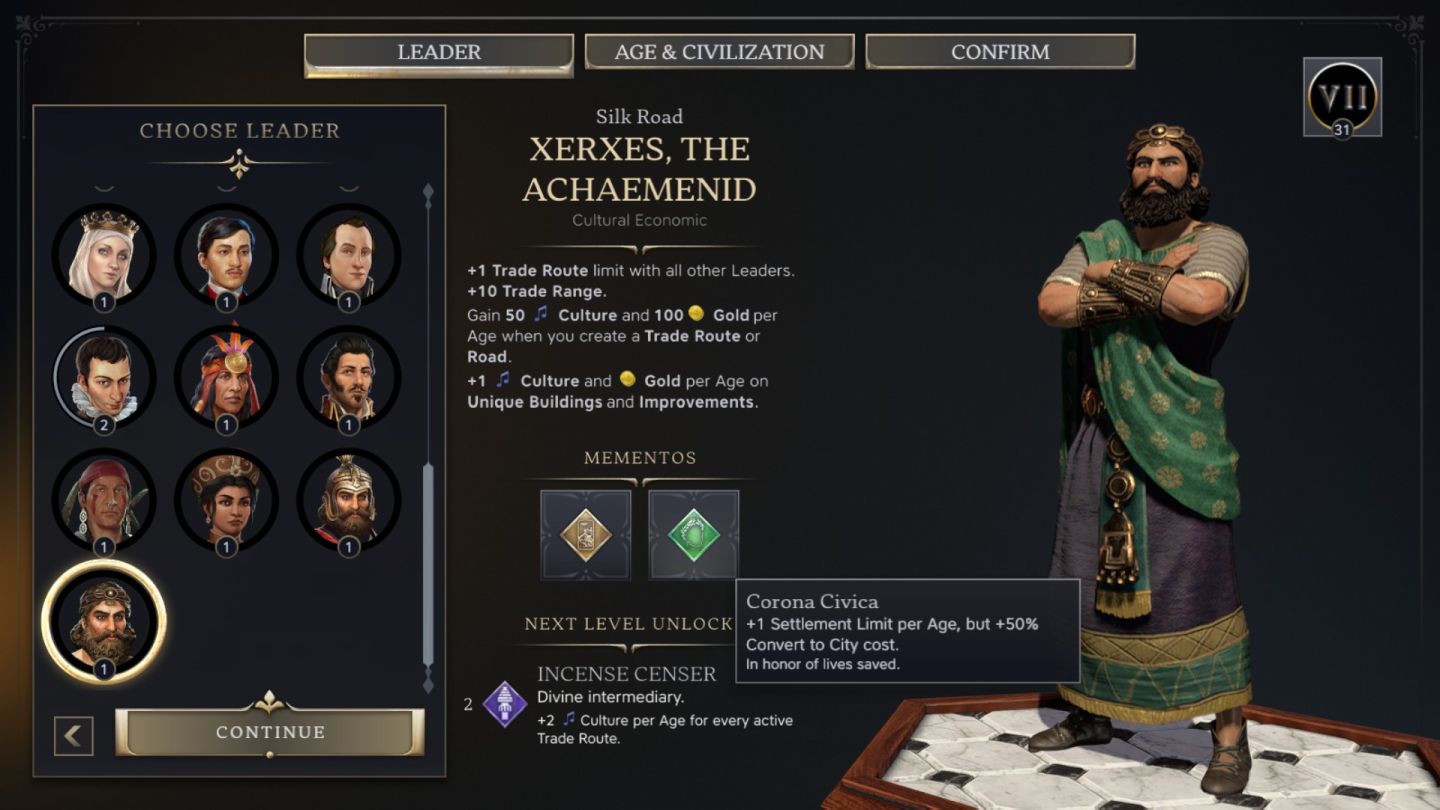
The biggest change from my first version of this variant is that I would not be dependent on unique tile improvements from the city states. No more need to frantically find Cultural and Military independent powers to unlock those megaliths and hill forts; the unique tile improvements would be covered by my civ choice this time around. That meant I could skip out on the Machiavelli / Greece combo for maximum influence generation and focus instead on a leader who would be better suited to this wacky concept. The clear pick was the Achaemenid version of Xerxes, who typically gets overshadowed by by the King of Kings version of Xerxes due to the latter having +1 settlement cap as an innate ability. Achaemenid Xerxes instead has several bonuses associated with trade routes, including +10 trade route range which was added in Patch 1.2.1 and dropped right before I started this game, and then the one ability that I actually cared about: +1 gold and +1 culture per age on unique buildings and tile improvements. This would be a huge boost to the unique tile improvements that I planned to spam everywhere.
I was further able to buff up those unique improvements by taking the Chalcedony Seal memento: another +1 culture and +1 gold on unique buildings and improvements, though the memento version doesn't scale with the later ages. I had used this in my previous attempt at the variant as well and it's actually one of the unlocks for playing a bunch of games as Achaemenid Xerxes. Doubling up on the same power was going to be a lot of fun if I could make it to the Modern era for +4 gold and +4 culture on every unique improvement. In the other memento slot I decided to take good old Corona Civica: +1 settlement limit at the cost of more expensive town to city conversions. I remembered that I had run towns over cities in my previous game and this would let me settle another one of them. This memento choice meant that I wasn't taking anything that granted additional food, however we'll soon see why that wouldn't be necessary this time around.
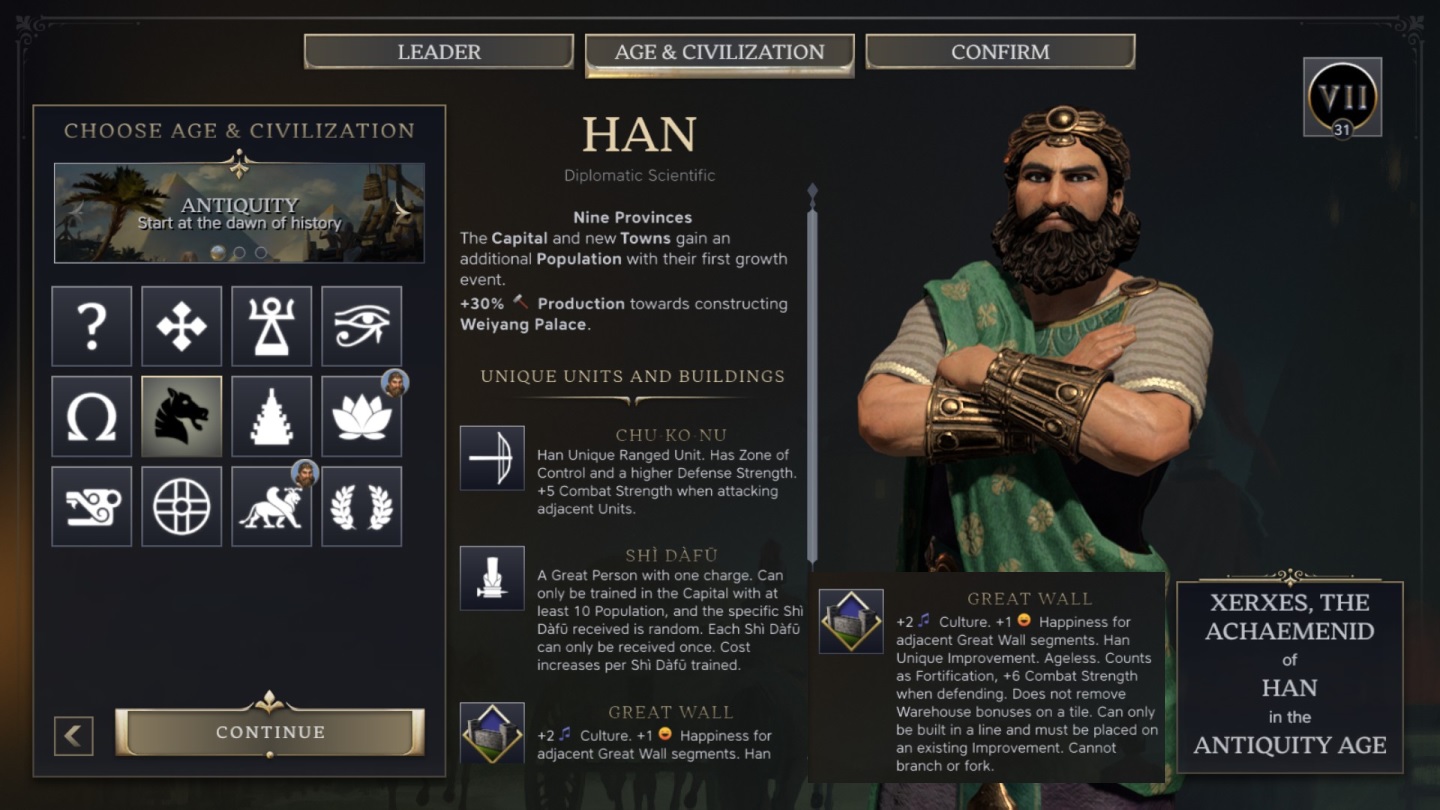
The civ choice had to be Han China as they were the empire with the bug that I'd be exploiting. I was well familiar with the Han thanks to using them in my sample game done for the CivFanatics Game of the Month, and with the passage of more time I've upgraded my opinion of this civ a good bit. Settlements getting an additional population point to start at size 3 instead of size 2 is a helpful bonus and the Chu-Ko-Nu is one of the better unique units for the early game, with extra defensive strength and +5 attack when shooting something right next to it. That happens a lot more than you might think in the Ancient era. The biggest advantage of Han China isn't even visible here on the menu screen, as they get several influence-generating traditions from their unique civics tree which scale really well into the late game. +1 influence on each science and each happiness building? That's downright awesome to have now that I know more about the value of influence generation. Too bad these policies would be useless for me under this variant.
The weakest part of Han China is probably the Great Wall tile improvement since this is worse than a unique quarter under normal circumstances, along with the nearly useless Shi Dafu. I'll have much, much more on the Great Wall shortly. I rolled a few starts using the same map settings as my previous try at this variant and soon the game was underway.
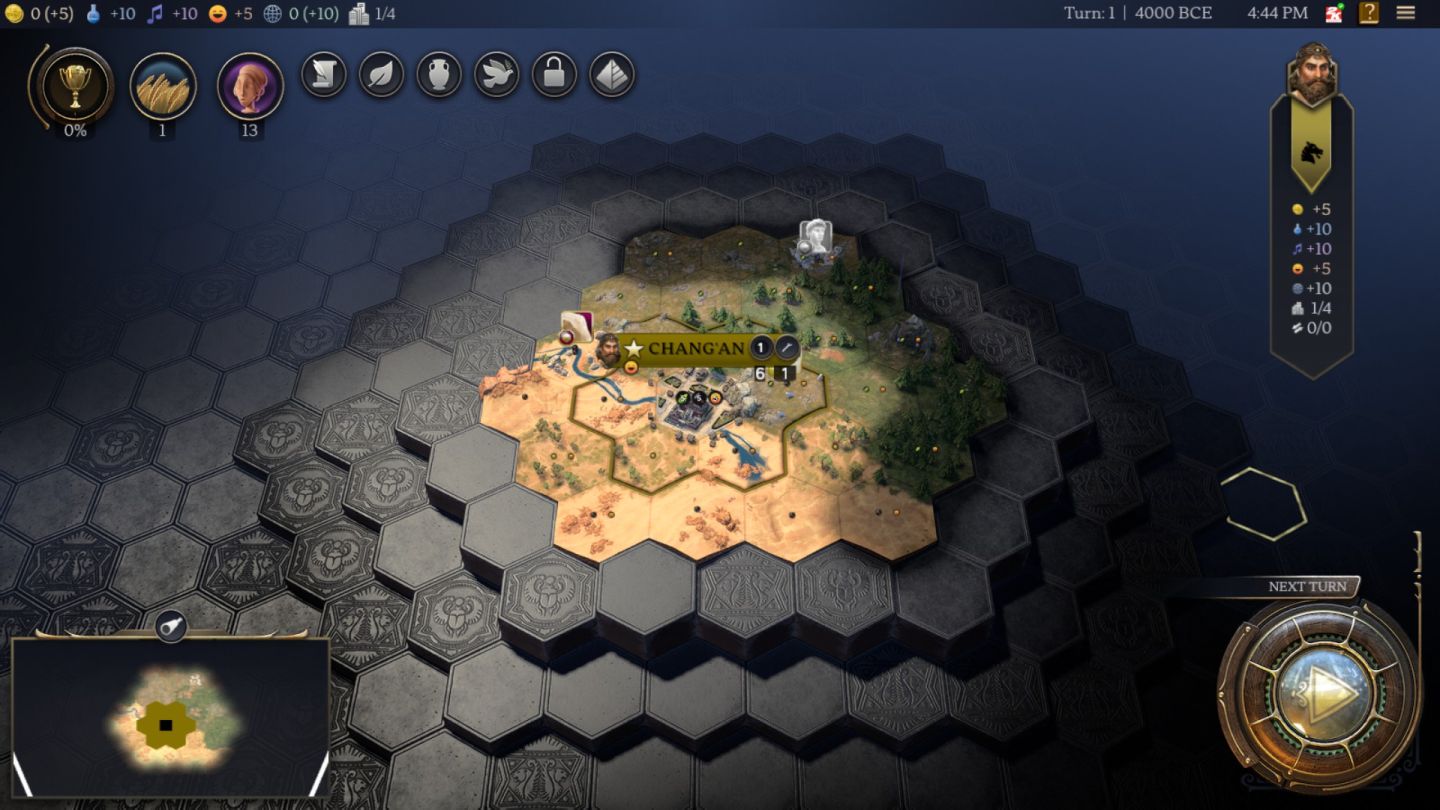
It became clear very quickly that Xerxes has a desert start bias as a leader in Civ7. I found my initial settler planted firmly in various dry portions of the map, spots that would be great for production while lacking much in the way of food. That was a problem because I needed to reach size 5 in order to train additional settlers, and under this variant I couldn't complete any buildings which would give me a "free" population size by counting as an urban district. It actually helped a good bit to be playing as the Han who started out with an extra population point at size 3; this saved 60 food which would have taken half a dozen turns to grow naturally. I played the opening turns of a few different starts and had to reject several of them because I couldn't get to size 5 quickly enough, falling too far behind on the civilization growth curve. This start probably would have been rejected as well except that one of my scouts pulled a growth event from a goodie hut that allowed me to trade a single turn's worth of culture for an extra population point in the capital. That was a spectacularly good trade and made this otherwise dry start into a playable opener.
Since I couldn't construct any of the intended buildings, I had the capital start out by training the initial 1-turn scout followed by three additional scouts. They spread out in all directions and began defogging the map while snagging a whole bunch of the tribal villages. I was using the "Balanced" map setting again and it's amazing how many more of the goodie huts are available when the map doesn't shove all of the AI leaders right up into the player's face. The capital of Chang'an reached size 5 on Turn 15 and I immediately rush-bought a settler along with queuing another settler via normal production. I had even saved up a few turns of production via Shift-Enter turn abuse so that second settler was already halfway finished on the turn that it started. Anything to get those settlers out on the map as fast as possible; if I couldn't construct buildings in this variant, I had to offset that disadvantage by being bigger than everyone else.
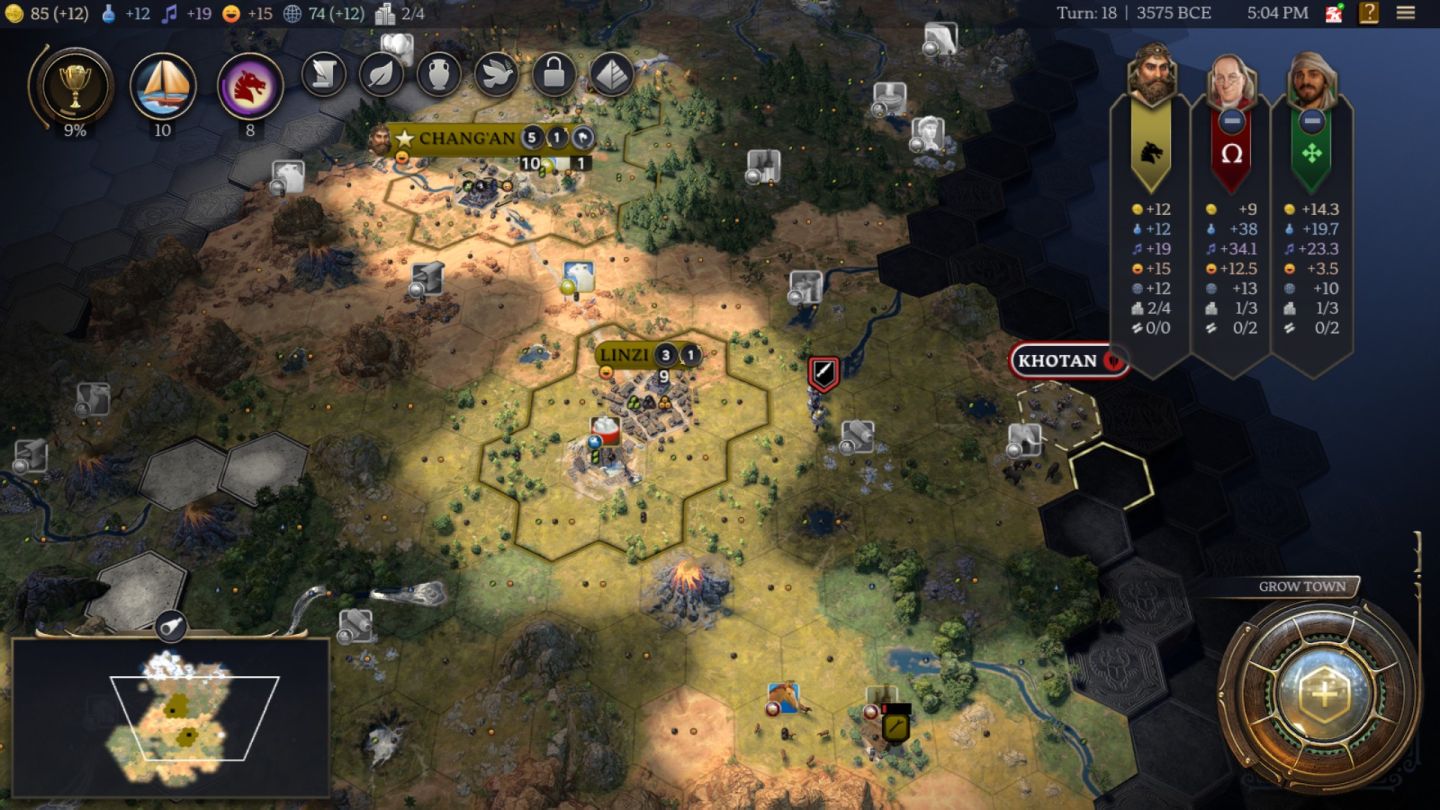
The first settlement went to the southeast at the pictured Linzi. I largely picked this location due to the sugar and sheep resources that were present, as the capital badly needed the additional food that the sugar could provide. This screenshot looks a bit weird since I took it after the initial growth to size 2 but before the second Han growth to size 3; I needed to plan out where this city was going to construct its later Great Wall segments before making a decision. Unfortunately there were several independent powers in the neighborhood and all of them rolled hostile, with the result that I had to spend the early game fighting off multiple waves of barbarian raiders. I had exactly zero military units thanks to opening with quadruple scouts into double settlers as I tried to push for maximum growth curve with a farmer's gambit. Those barbarians did punish me a bit by forcing a Cho-Ko-Nu purchase (thankfully only 120 gold) at Linzi along with another naturally built Cho-Ko-Nu out of the capital to defend the second settler. I was also helped by a random narrative event that gave me a third Cho-Ko-Nu for free and the trio of them proved to be sufficient for early game defense.
One of the unusual aspects of this variant that I had learned from my previous attempts was that science really didn't matter much. The whole tech tree largely just unlocks more and more advanced buildings, a whole bunch of different buildings that I could never construct. Therefore I could ignore science after some of the initial techs that boosted rural tile yields and concentrate instead on culture. After having no choice on researching the initial Chiefdom civic, I went immediately into the Han civics tree and picked the Zhi option. This civic was quite cheap at only 150 culture and unlocked the Great Wall tile improvement along with very helpfully having +1 settlement limit. Along with the Corona Civica memento, this would get me up to a cap of 5 at a very early date and unlock further expansion, plus the cheap Irrigation tech has another +1 settlement to reach half a dozen. My capital was going to be busy spamming out settlers for quite a while.
The other thing that it would be building was Great Wall segments, lots of Great Wall segments. So here's more information than you ever wanted to know about how the Great Wall unique tile improvement works in Civ7:
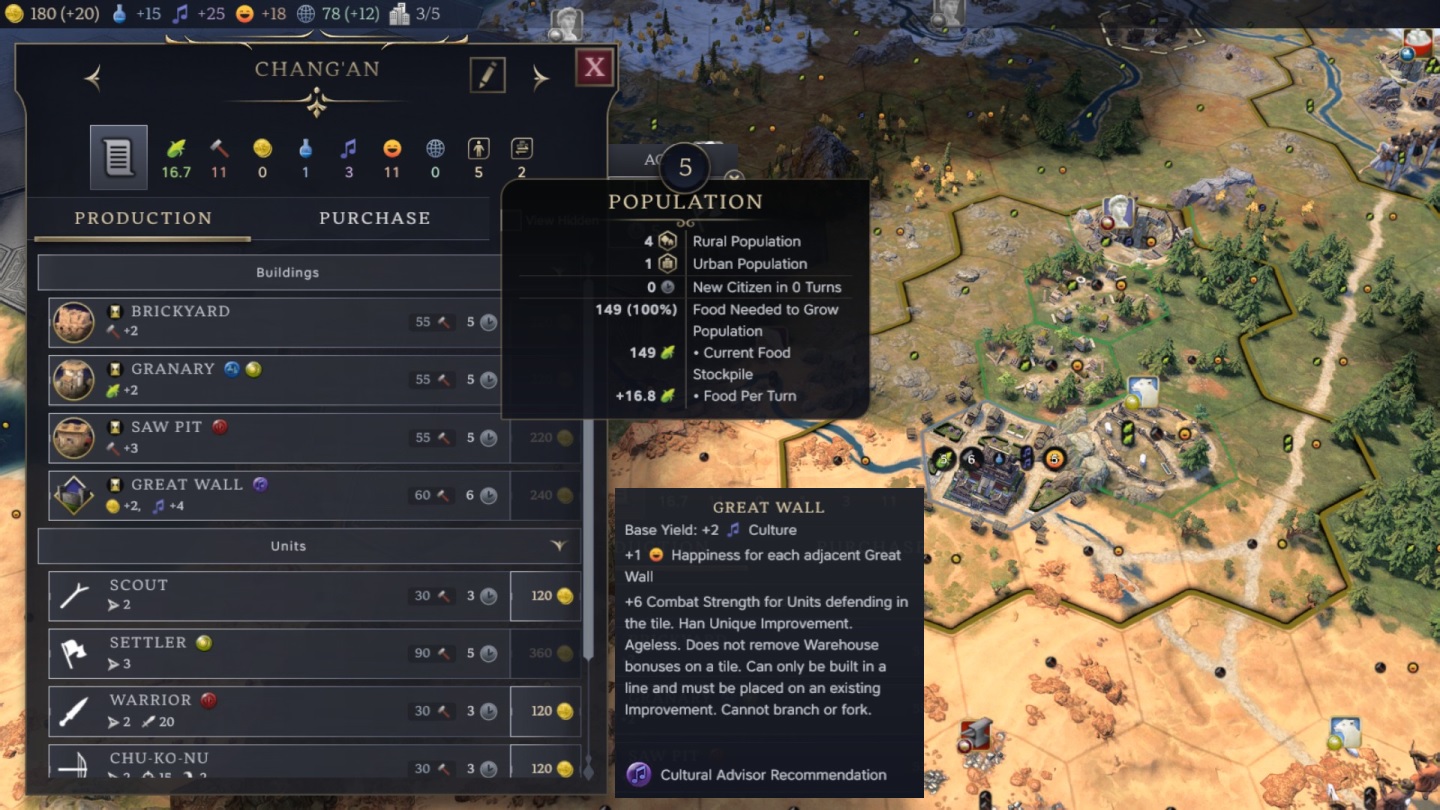
Like all unique tile improvements, the Great Wall can only be placed on top of an existing rural tile that has already been improved. The Great Wall adds onto the preexisting tile yields, granting a base benefit of 2 culture along with 1 happiness for each adjacent Great Wall. Due to my leader and memento choices, I would also be getting an additional 2 culture and 2 gold such that most of my Great Wall segments would have a total yield of 4 culture, 2 gold, and 2 happiness along with whatever yield the rural tile had underneath, not too bad! The biggest restriction of the Great Wall is that the segments can only be built in a line and cannot branch or fork. In practice, this means that each new segment of the wall can only move in three directions: if the previous wall segment went to the east, for example, then the next wall segment can only go northeast, east, or southeast. Keep in mind as well that Great Wall segments can't be built on top of resources or on mountains or coastal terrain. This allows for a decent bit of flexibility to wind the wall around various obstacles while also creating real barriers in mountainous or resource-heavy parts of the map. It was going to be important to plan out the wall paths ahead of time to avoid having them get stuck at unintended dead ends.
Now here's the single biggest factor that made me play this variant a second time: THE GREAT WALL IS BUGGED. This bug has been around since the game was released and hasn't been corrected yet despite Civ7's developers issuing four major patches and multiple smaller technical fix patches during that span. And this isn't some kind of obscure mechanical issue, it's a really obvious and blatant bug that should be trivial to correct. The issue is that when a settlement builds a Great Wall segment it *LOSES* a population point! 
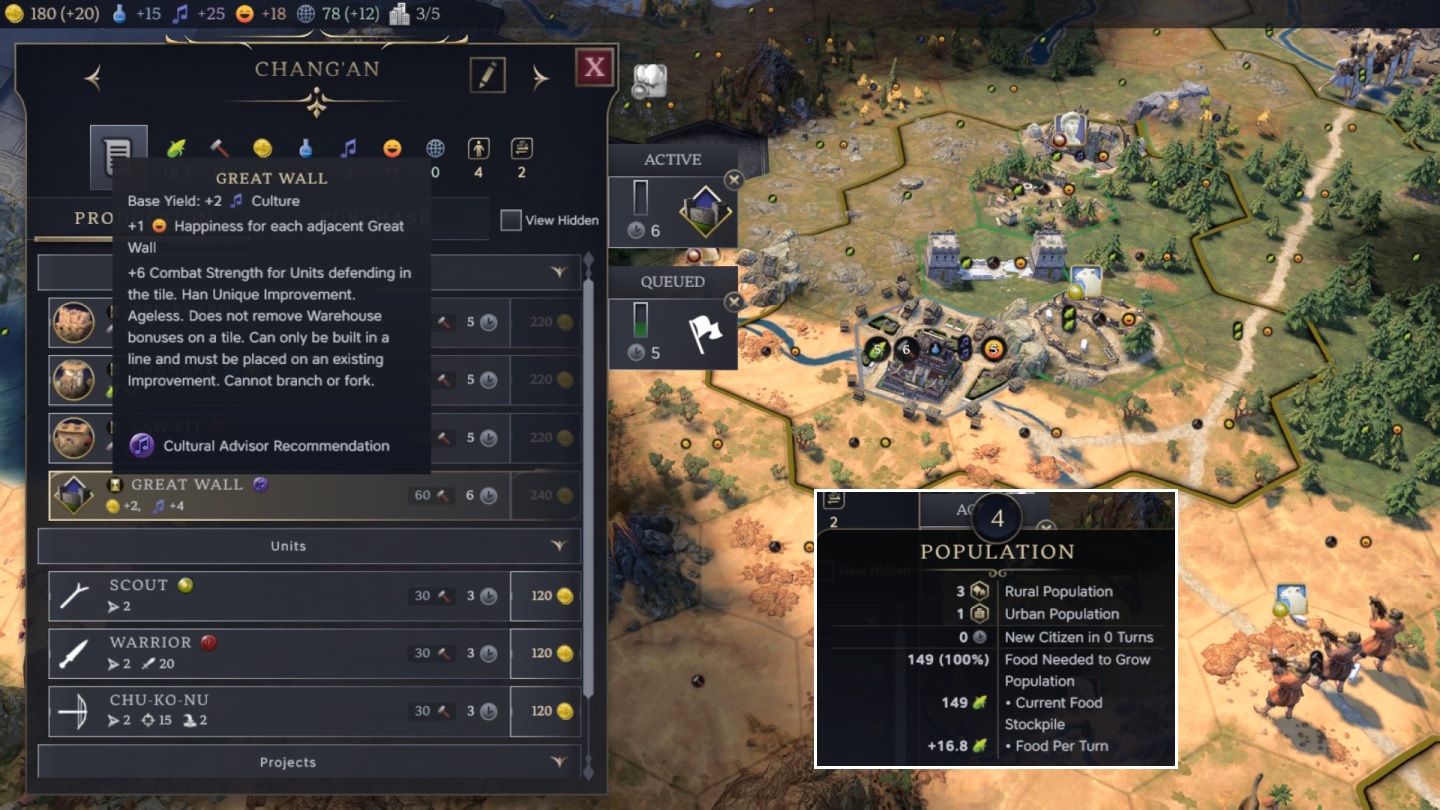
Compare the population numbers in the two screenshots above. Chang'an was building a settler at size 5 and about to grow to size 6, then when I swapped it over to the newly-discovered Great Wall it fell down to size 4 again. What's really interesting about this is that the food box itself doesn't change in the process; Chang'an continued to use the size 5 food box of 149 food rather than the size 4 food box of 101. However, when Chang'an experienced its next population growth, it would continue to use the 149 food box (since it had returned to size 5) instead of going up to the normal size 6 food box of 205 food. Therefore if I could keep adding more Great Wall segments, I could keep Chang'an locked at a food box of 149 instead of needing ever-escalating food requirements which would reach the thousands before the conclusion of the Ancient era. The pattern here was obvious: grow a size, use that new size to add a Great Wall segment, drop down to a lower population size, then rinse and repeat with the food box never getting any larger. This would solve my biggest problem from the Machiavelli game of not being able to get enough food to keep my settlements consistently growing - no need for megaliths if the food box never gets any bigger!
A few more words on the Great Wall mechanics, feel free to skip ahead for those not interested. The population decrease does not take place when a Great Wall segment is completed, as you would probably expect. Instead, the population of the settlement goes down when the Great Wall is selected in the build queue (?!?) which really makes me wonder how this is programmed. In fact, this effect only triggers if the Great Wall happens to be the first item in the build queue as the pop decrease doesn't take effect if it's the second or third item listed. You can even toggle this back and forth in the build queue: settler (size 5) -> Great Wall (size 4) -> settler (back to size 5 again) and so on. The pop decrease doesn't become permanent until the Great Wall segment completes and appears on the physical map. What an utterly bizarre effect; given how obvious and repeatable this is, I can't believe that it hasn't been fixed yet by the developers. (Someone at CivFanatics said that this is as simple as changing a "1" value to a "0" value in the coding, no idea if that's true though.)
To be clear, this was extremely abusive exploiting of an unintentional bug and not the way that Civ7 was intended to be played, but if the developers couldn't be bothered to patch it out, I was going to have fun with it for a single game. 
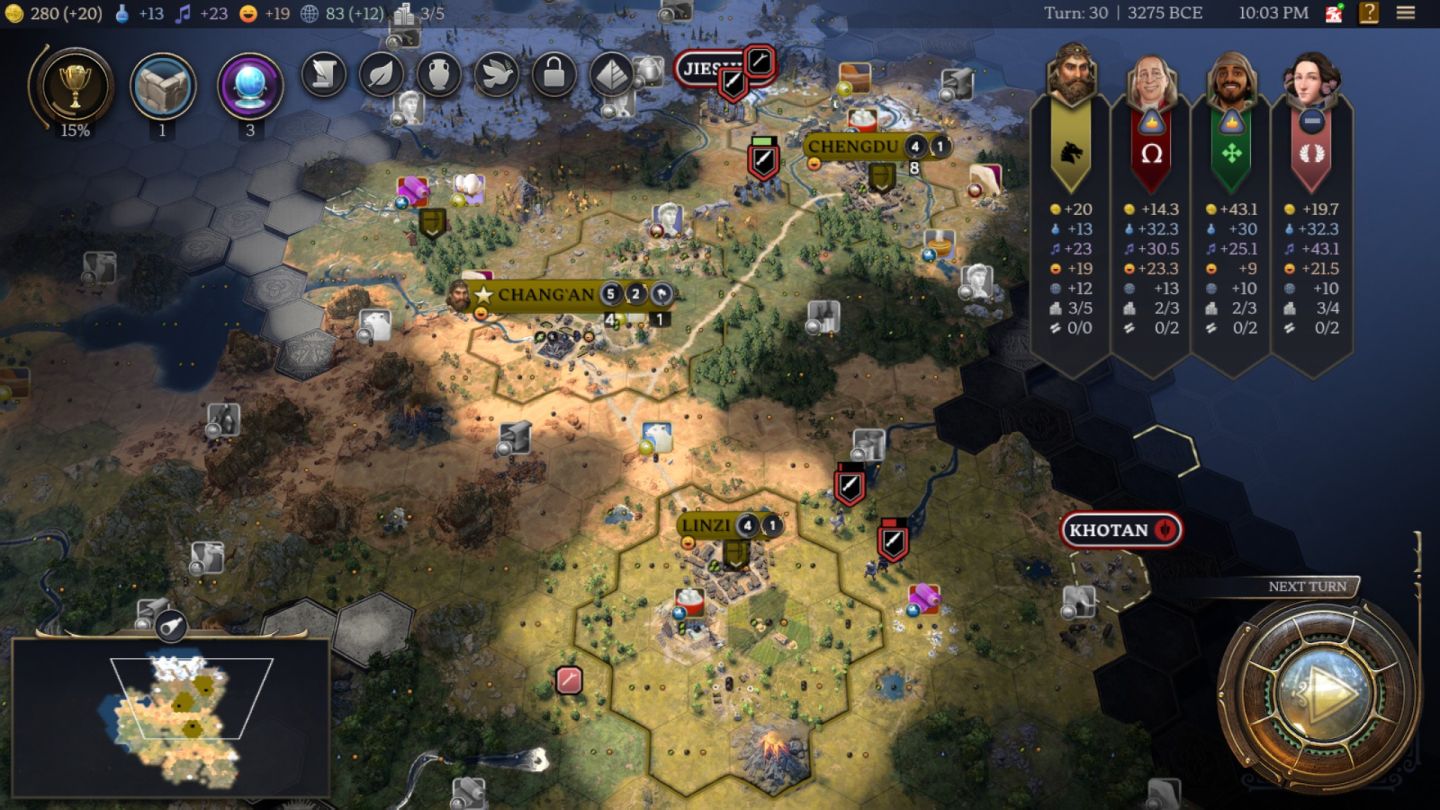
Anyway, the gameplan for the Ancient era was now revealed: expand to as many settlements as possible and spam Great Walls everywhere, walls as far as the eye could see. My third settlement had gone to the northeast at Chengdu where I secured another sugar resource for the capital. I wasn't focusing nearly as much on resources as usual in this game, however, as any population growth that went onto a resource wasn't one that could be canceled out with a Great Wall later. For example, if I avoided all resources and did nothing but grab wall-eligible tiles, I could theoretically keep a settlement locked at size 3 where the food box was a mere 45, though in practice I didn't have the production or gold capacity for cash-rushing to make that practical yet. Later on though, well, we'd have to see when I was richer and had more money to fling at new towns. For the moment I was more concerned with the barbarians raiding my settlements as Chengdu was also situated near a hostile Military IP. At least there were plenty of rivers up there for the Cho-Ko-Nu to fire behind.
I had also met the other AI leaders on my starting continent by this point: Benjamin Franklin, Ibn Battuta, and Ada Lovelace. What a bizarre group of non-traditional Civilization leaders, heh. This was a good draw in terms of the random opponents as all of these AI leaders were on the peaceful side of the spectrum. Franklin is pretty easy to turn into an ally if you share his government, though that wasn't the case here, while Ibn Battuta is probably the single easiest AI to befriend in the whole game. His agenda is that he likes leaders who defog the map and that's something which I always do. There are tons of benefits from exploring the map in Civ7 between goody huts and independent powers and sheer additional information, I always make sure to defog everything and thus Ibn Battuta always loves me. Ada Lovelace likes leaders who complete lots of tech and civic masteries which also tends to make her an easy friend. That could be tougher in this game with very little science but I figured I could do all of the civic masteries and at least break even on her agenda.
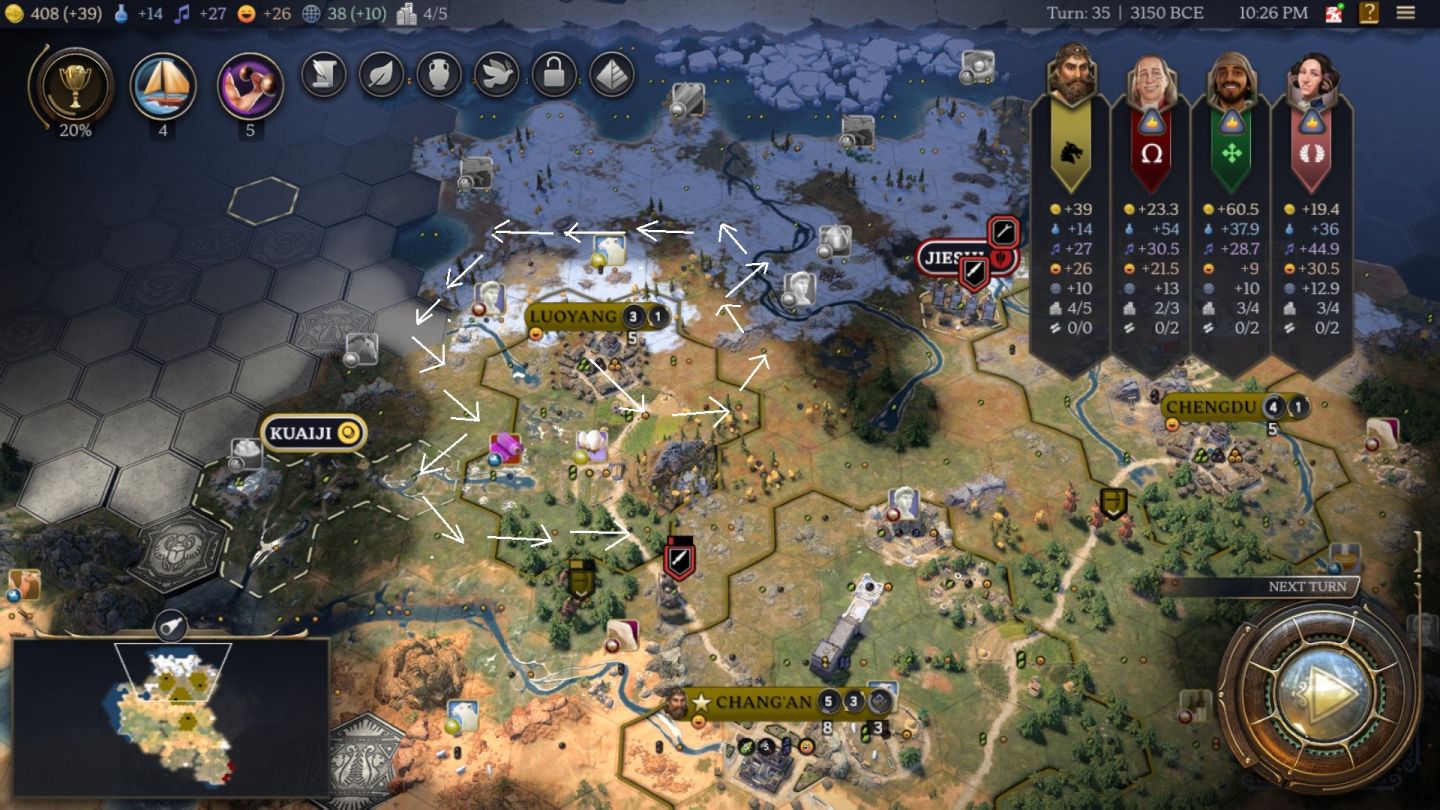
Settlement #4 went to the northwest at the pictured Luoyang where there was another independent power, though this one rolled as Commercial and wasn't immediately hostile. I had already tossed 170 influence at Kuaiji to start the friendship process as otherwise it would have gone hostile from having a new settlement right next door. In any case, I included my screenshot above indicating how I planned out the future Great Wall segments at Luoyang. Oftentimes the terrain blocked where I would have liked the wall to go thanks to various stuff getting in the way, however Luoyang had a nearly perfect counter-clockwise circle which would surround the settlement. If I could somehow get a Great Wall segment on the tile west of the silks held by the independent power at the moment, I could legitimately have an 18-tile Great Wall before running out of space. That would take at least the whole Ancient era to complete and probably most of the Exploration age as well. I would end up drawing these diagrams for every one of my settlements, and while that did get tedious over time, I needed to have them ready as a reference so that I could have the ideal Great Wall paths mapped out ahead of time. One incorrect tile placement and the walls could come crashing to a premature halt.
It was shortly after this that I payed 450 gold to upgrade Linzi into a city, eating the 150 extra gold cost due to that Corona Civica memento. The new city continued to see heavy barbarian activity, including an army commander that unloaded four units at once:
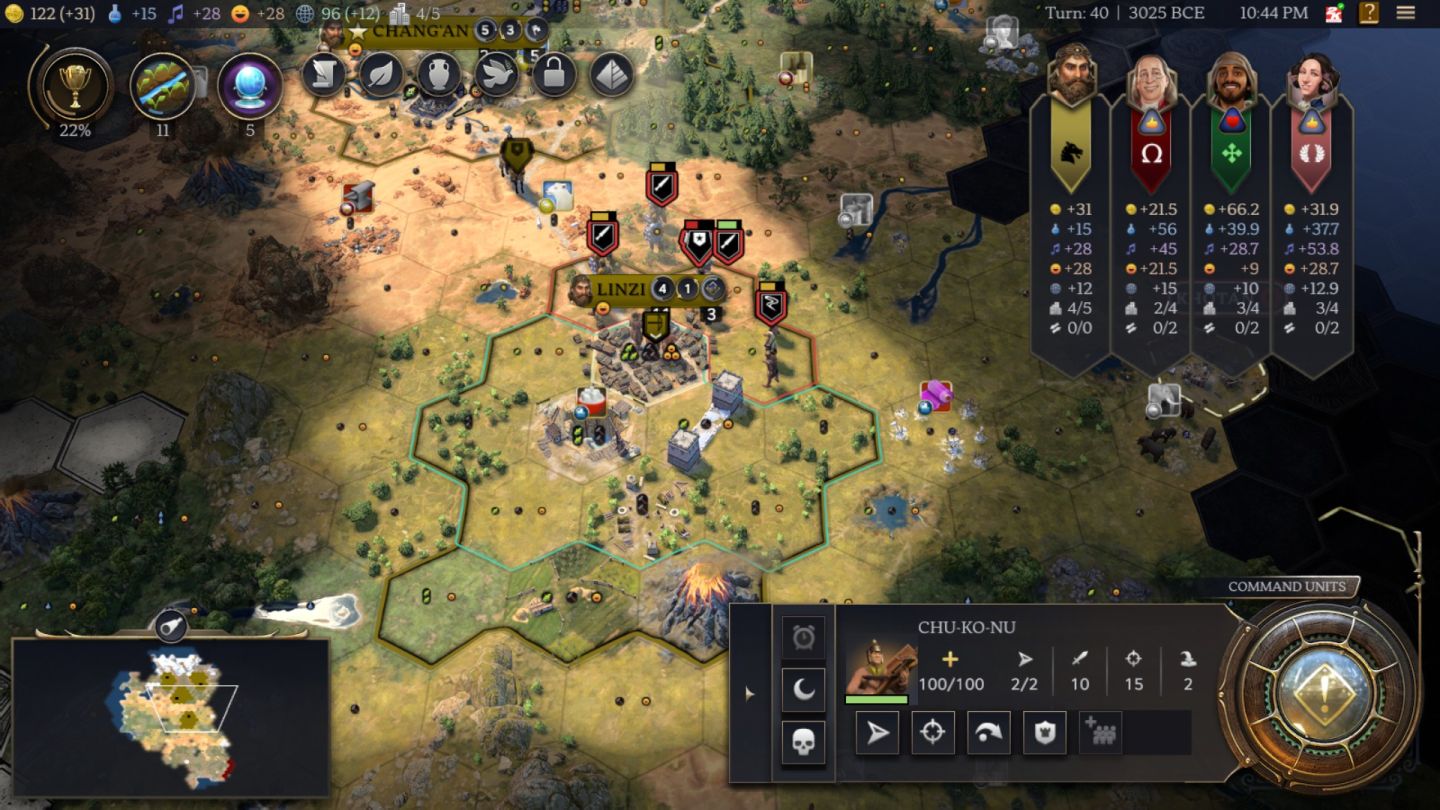
Seriously, what the heck was this?! I had my own army commander who had unlocked at the Discipline civic heading down there and I was forced to cash-rush another Cho-Ko-Nu to be on the safe side. I even managed to get some value out of the Great Wall's defensive aspect, with one of my two archers standing on the wall segment where it received an additional 6 combat strength on defense. As scary as this situation may have looked, the barbarian AI turned out to be completely useless as these units mostly shuffled around doing nothing in particular while my Cho-Ko-Nu pair shot them to death. I've said this a bunch of times in my Civ7 reports: the AI can defend itself by spamming out units but it suuuuuuucks when it comes to doing anything offensively with them.
Outside of the barbarian raids, these continued to be quiet turns. All of the AI leaders were far enough away that I hadn't seen much from their units or settlements thus far, which was completely fine with me. I was doing my best to stay on friendly terms with each of them, occasionally supporting endeavors to build diplomatic relations while mostly saving my influence for additional city state friendships. Commercial Kuaiji was the first to reach full alliance status on Turn 49 where I took the Gemstones option: receive a lapis lazuli resource in your capital worth 4 production and 5% additional gold. That was the most useful option for the moment and I had another Commercial friendship already ripening which I'd use later on the 5% additional gold per city state alliance option.
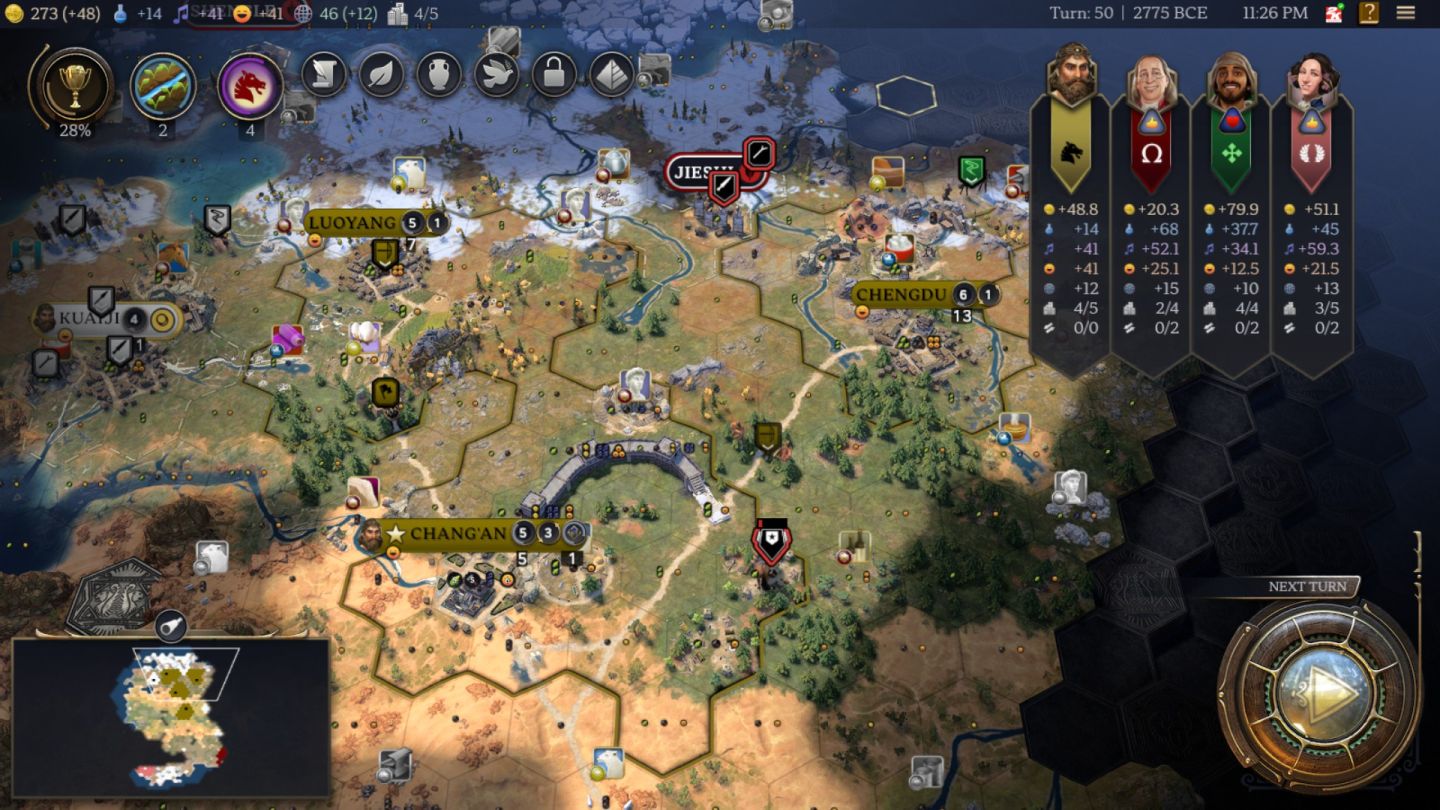
Fifty turns into the game my territory looked much the same as it had a dozen or two turns earlier. Chang'an had been size 5 earlier and it was still size 5 thanks to Great Wall bug abuse. Three of the segments were already done and a fourth was nearly completed as the first wall of the game started to take shape. Chengdu and Luoyang were developing nicely thus far, maybe even too nicely since I wanted them to stay at small sizes until I could start reducing their populations with Great Wall segments. Production in my two cities had been split between settlers and Great Wall segments, a pattern which would continue for the forseeable future; the pictured settler would found settlement #5 over in the west a few turns later. I was still trailing the other AI leaders in all of the various civ-wide stats though that was to be expected here on Deity difficulty. At least I was out-expanding them and more settlements would mean more Great Walls.
My initial plan had been to upgrade Chengdu to a city as well, matching the pattern of my Machiavelli game by working with three total cities and then a whole bunch of settlements. However, as the Ancient era continued to play out, I soon decided that there was no need for another production queue. My civ's income was rising rapidly thanks to getting 2 gold on every Great Wall segment, plus whatever production happened to be located on the underlying tiles in the towns. Since all of the towns could use the Growth focus to increase in size 50% faster, plus take advantage of town-based policies like Castes (+25% food in towns), there wasn't much of a need to spend a big lump sum of money to turn Chengdu into a city. There were better things to spend that money on:
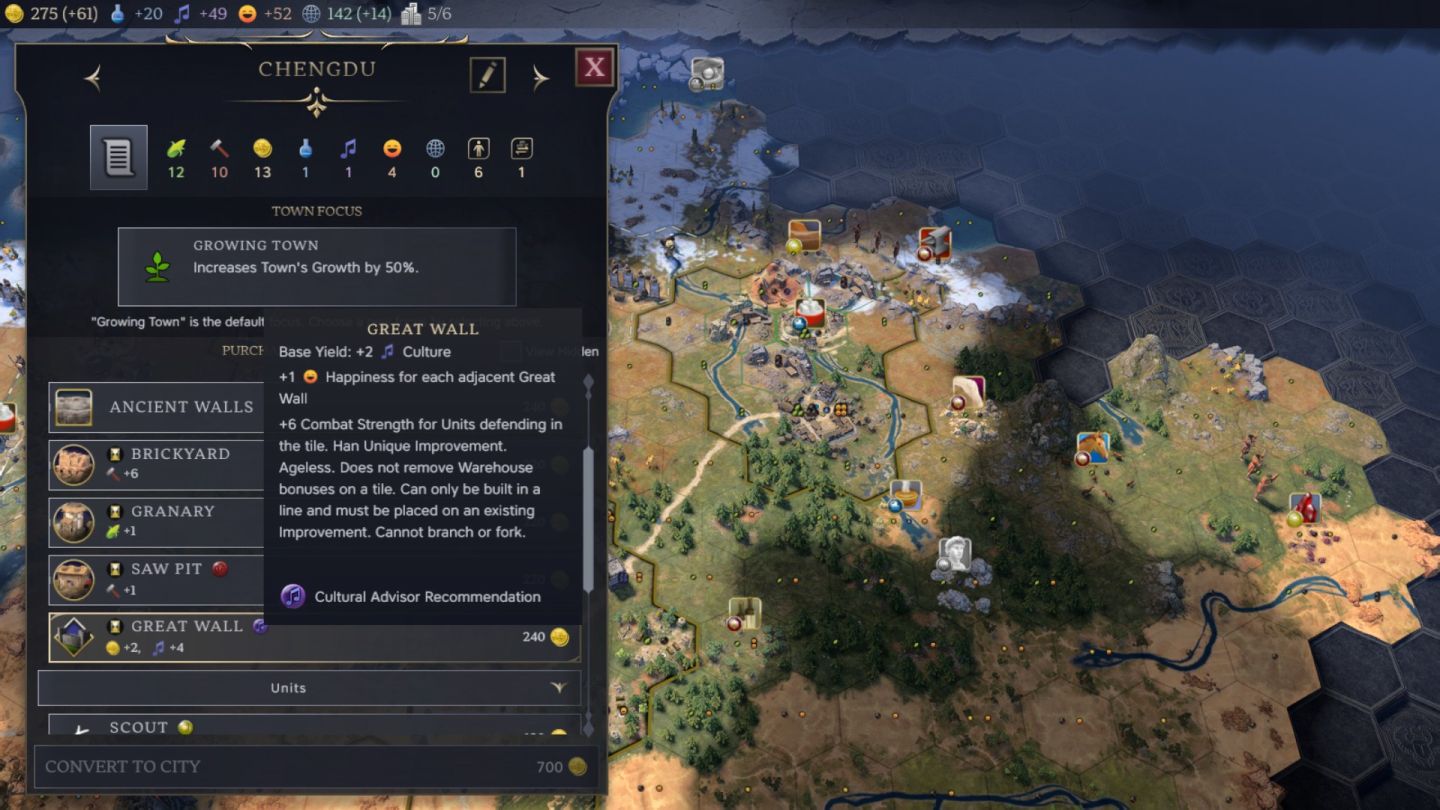
Such as more Great Wall segments, of course! Each Great Wall costs 60 production in Civ7 which translates into a base cost of 240 gold under Civ7's 1:4 production into gold conversion rate. Although that was expensive for the moment, it was starting to become less so as my civ-wide income continued to increase. I could also make these Great Wall purchases cheaper by finding gold resources on the map, each of which decreases the cost of rush-buying buildings by 20%. There were none in my immediate surrounding area though I had found a gold resource off in the western jungles which I was planning to settle down the road. A single gold resource would cut the cost from 240 to 200 gold per Great Wall segment and that would help a lot. For the moment, I had barely enough income to hold Chengdu and Luoyang at size 6 where they each needed 205 food to grow. I did not want them to grow another size where they would require 269 food for an increase of roughly 30%!
I planted my sixth settlement in the south just after Turn 60 and then paused expansion briefly to work on a wonder at the capital. By far the most important Ancient era wonder for this variant was the Hanging Gardens and I did manage to complete it in Chang'an at the late date of Turn 63. I had been sweating out completion of that wonder over the final turns since it often tends to be taken quickly by the AI leaders, though I was using Shift-Enter production abuse again and could have diverted to another wonder if it had been taken. The Hanging Gardens grants every settlement +10% growth for the rest of the game and that would be absolutely gigantic for this variant. To take the example from the previous paragraph, now Chengdu and Luoyang would need 184 food to fill up their food boxes and I became very familiar with that number, as they would hit it over and over again with me knocking down their population with Great Wall segments after each growth.

With the Hanging Gardens out of the way, it was time for more expansion again as Chang'an started yet another settler. I would end up double-expanding here with a settler out of the capital and another one rushed out of Chengdu at a cost of 600 gold. I could have funneled that money into more Great Wall segments but felt it was more important to keep pushing across the map before the land could be claimed by someone else. Happiness was no problem at all, not with several more increases to the settlement cap upcoming from the main civics tree and the Great Walls themselves providing additional happiness. Remember that a side benefit of the Han Great Wall segments is that they provide +1 happiness for every other Great Wall bordering them, which tends to mean +2 in practice from having another wall on either side. This allowed me to be aggressive in going over the settlement cap since every new town could simply cash-rush more walls to get itself out of unhappiness. This was turning into a bit of a sandbox exercise on how far I could push expansion and growth before being called on it.
And the AI civs were playing along beautifully as they soon fell into pointless internecine squabbling. Take a look at the minimap in the corner of that screenshot above. Do you see the vast tracks of unsettled land all over the place? There was no reason for Ibn Battuta to launch a war against Franklin, not when he had open territory to settle everywhere along his borders. Maybe he had happiness issues stopping him from further expanding, but if that were true then a war of aggression would hardly solve the problem. For his part, Franklin had a mere *TWO* settlements (!!!) after 65 turns on the top difficulty level so I have no idea what kind of weed he was smoking. Ada Lovelace would later join in with her own war against Ibn Battuta so she was absolutely no better. I tell you, the AI is a complete idiot in this game at the most basic aspects of development. Why don't they expand faster? Why do they fight these pointless wars? It feels like it would be really easy to get them to play better with some minor tweaks - build more cities, you morons! 
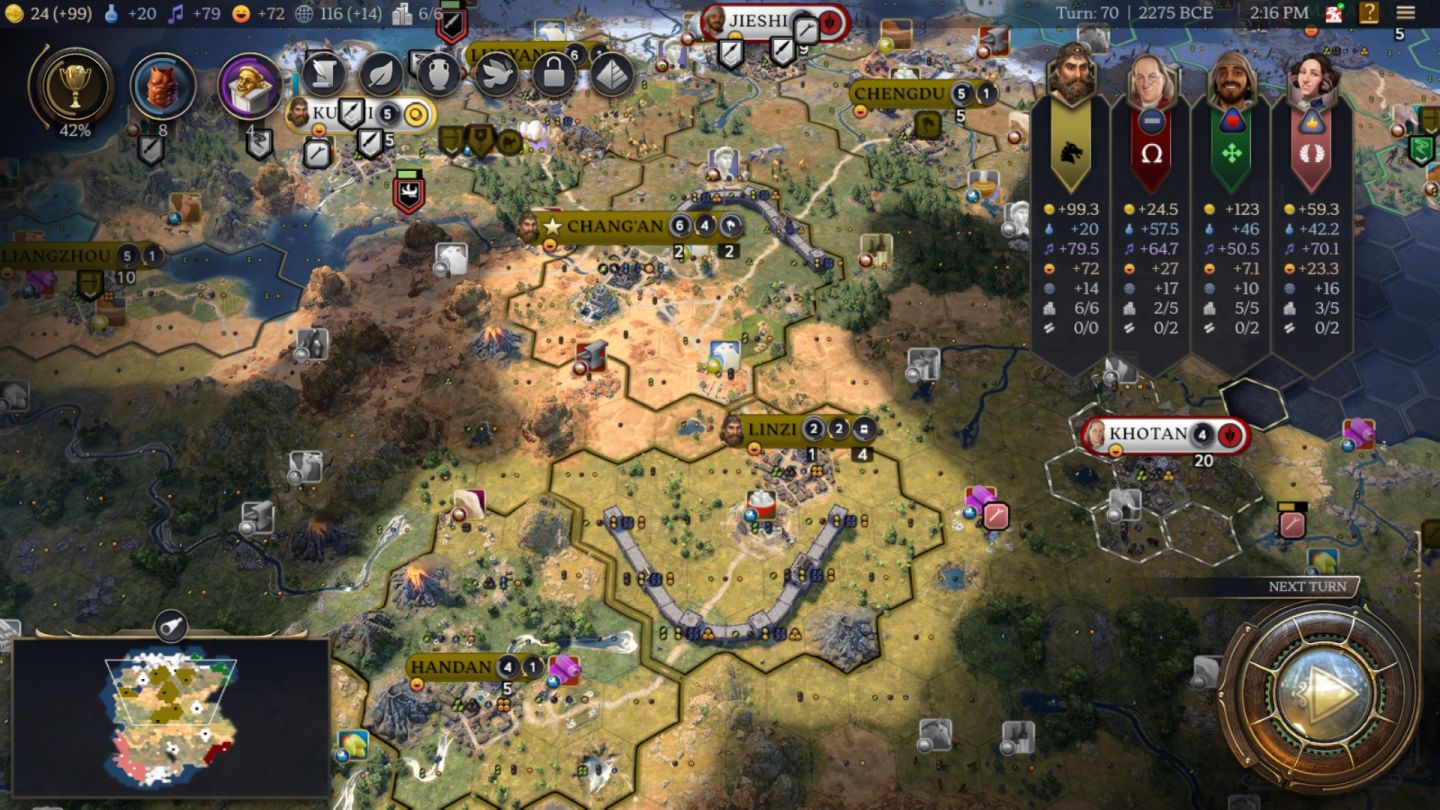
That warring unquestionably slowed down the AI leaders as my wall-building civilization had essentially caught up to them by Turn 70. I had more settlements than any of them at a half dozen and two more settlers already on the map heading to new sites, soon planting towns on the eastern and western sides of my borders respectively. Gold/turn income was rising rapidly and about to surpass Ibn Battuta after having already left the other two leaders in the dust. I was also the leader in culture and about to take off in that category as well; it certainly helped when every Great Wall segment was worth 4 culture/turn. That was enough to put monuments to shame, though monuments buffed by city state alliances can get even more insane yields. The one category where I was truly lagging was science and fortunately I didn't really need anything more in there. I already had all of the stuff that boosted rural tile yields along with the only increase to the settlement cap on the tech tree. I was researching Bronze Working to unlock the tier 2 archers and that would be enough to ensure military safety for the rest of the era.
Over the next few turns, those settlers on the map took my Chinese civ up to eight settlements and that along with a few more city state alliances seemed to put my empire over a tipping point. I unlocked the +5% gold per city state friendship policy and I think that I had three of them under my control for 15% total bonus. This was enough to raise my income from 100 gold/turn in the above screenshot to 150 gold/turn by Turn 80, then 200 gold/turn by Turn 88. The process was only accelerating over time since more gold income meant that I could cash-rush more Great Wall segments, which meant my towns staying at smaller sizes and growing faster, which meant more Great Walls and more income and so on. I was trying to see if I could cap my newest settlements at the minimum size 3 where they only needed 41 food to grow. That was enough for growth every 3-4 turns and it was a complex juggling act to keep supplying them with more Great Walls and then dropping their population before they grew again.

On top of my income ballooning from more settlements and more Great Walls, it was actually getting cheaper to purchase the walls as well. I was able to connect the only gold resource in my region with settlement #8, and then I made sure to run a merchant over to Ibn Battuta as soon as I spotted that he had another gold resource at his capital. The pair of them dropped the cost of each Great Wall segment to 168 gold apiece which meant that I already had enough money to rush one every turn. There was a final gold resource in the extreme southern tundra which unfortunately wasn't realistic to reach, that would have decreased the cost even further to a mere 150 gold. As for this trade route to Ibn Battuta, I actually had access to an additional trade route with every AI leader by virtue of playing as Achaemenid Xerxes. I ended up training a bunch of merchants out of Linzi when it didn't need to construct Great Wall segments, and these were useful for collecting more resources as well as building positive diplomacy with the other AI leaders.
One of the most fun aspects of playing this game was watching the Great Walls physically appear on the map as they snaked around each settlement. They were already starting to get a bit ridiculous and I hadn't even finished the Ancient era yet. Eventually I did run into a flaw in my planning though:
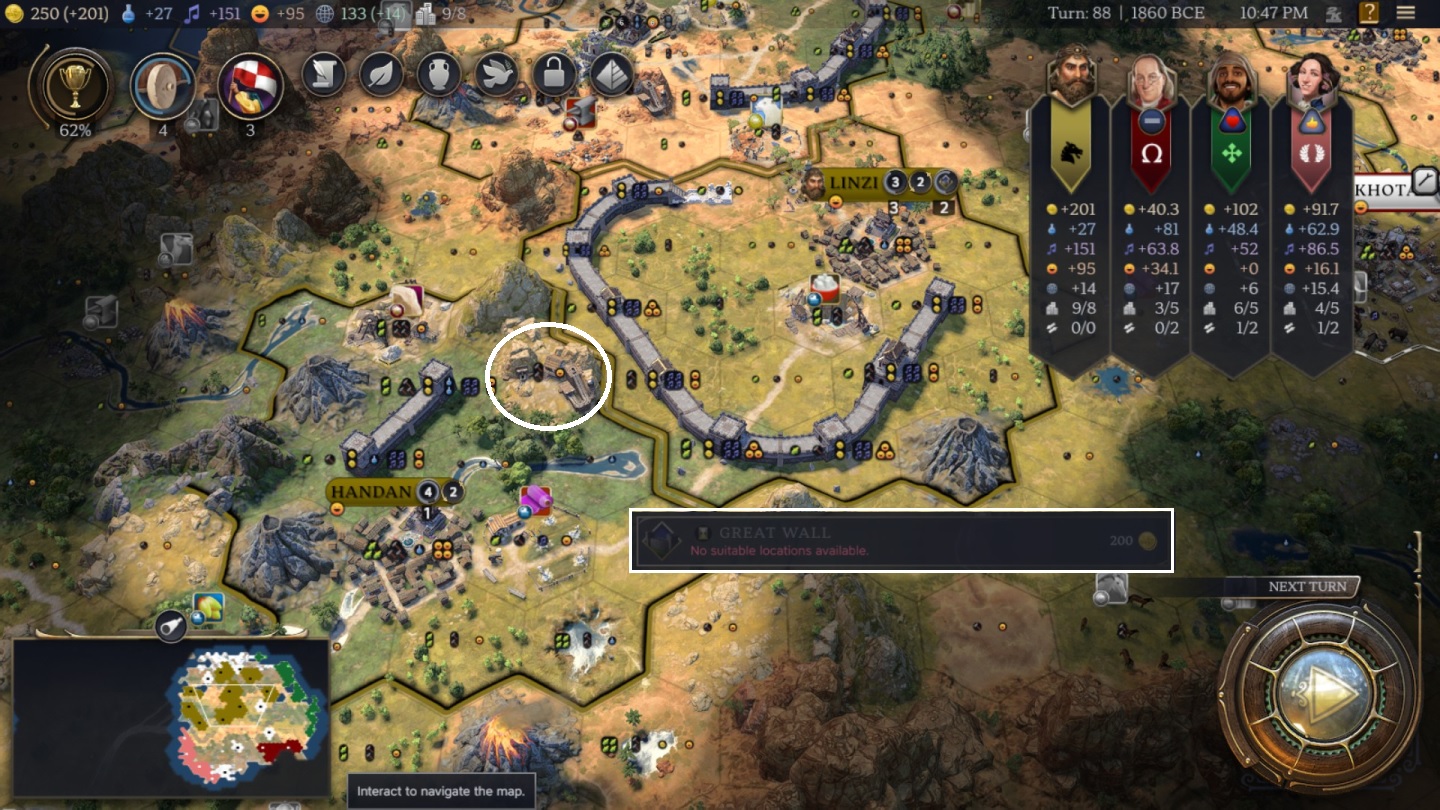
There was a wall conflict along the border between my cities of Linzi and Handan. Linzi had already finished its Great Wall in this area and the plan had been for Handan's wall to curve to the northeast and then east around the newer settlement in clockwise fashion. However, when I went to purchase a wall segment on the circled tile, the interface told me that this was not an eligible tile. It certainly should have been as the tile in question could connect to the rest of Handan's wall and then continue running southwards from there. Apparently this was yet another undocumented mechanic in Civ7: two separate Great Walls can't touch one another as the game seemingly interprets this as the wall trying to fork. That's quite dumb and there's absolutely no explanation of this anywhere within the gameplay but it appears that the game does indeed function this way. I was forced to rework the Great Wall planning for most of my settlements which was definitely annoying, and the towns of Liangzhou and Jinyang along the western coast ended up closer together than I would have placed them had I known about this undocumented rule ahead of time. Here's their reworked Great Wall plan for the curious after I discovered this hidden rule.
This new information caused me to shift some of my following settlements a bit further apart where they'd have more space and less overlap with my existing towns. There was no pause in the ongoing expansion as I followed the double expansion to eight settlements with another triple expansion all the way out to eleven settlements. The ninth one was planted on Turn 88, the tenth on Turn 99, and then the final eleventh on Turn 100. This put my civ three settlements over the cap at 11/8 which was as high as I could go for the moment. The settlement limit in the Ancient era is 6 from the default tech and civics tree, then I had the seventh point from the Han China civics tree and the eighth point from my Corona Civica memento. Being three settlements over the cap was nowhere near as bad in this game as it would have been normally thanks to having all those Great Wall segments to boost happiness. The newest towns were in negative happiness until they could get their walls built but everywhere else was still running in the positive numbers and that was good enough for me.
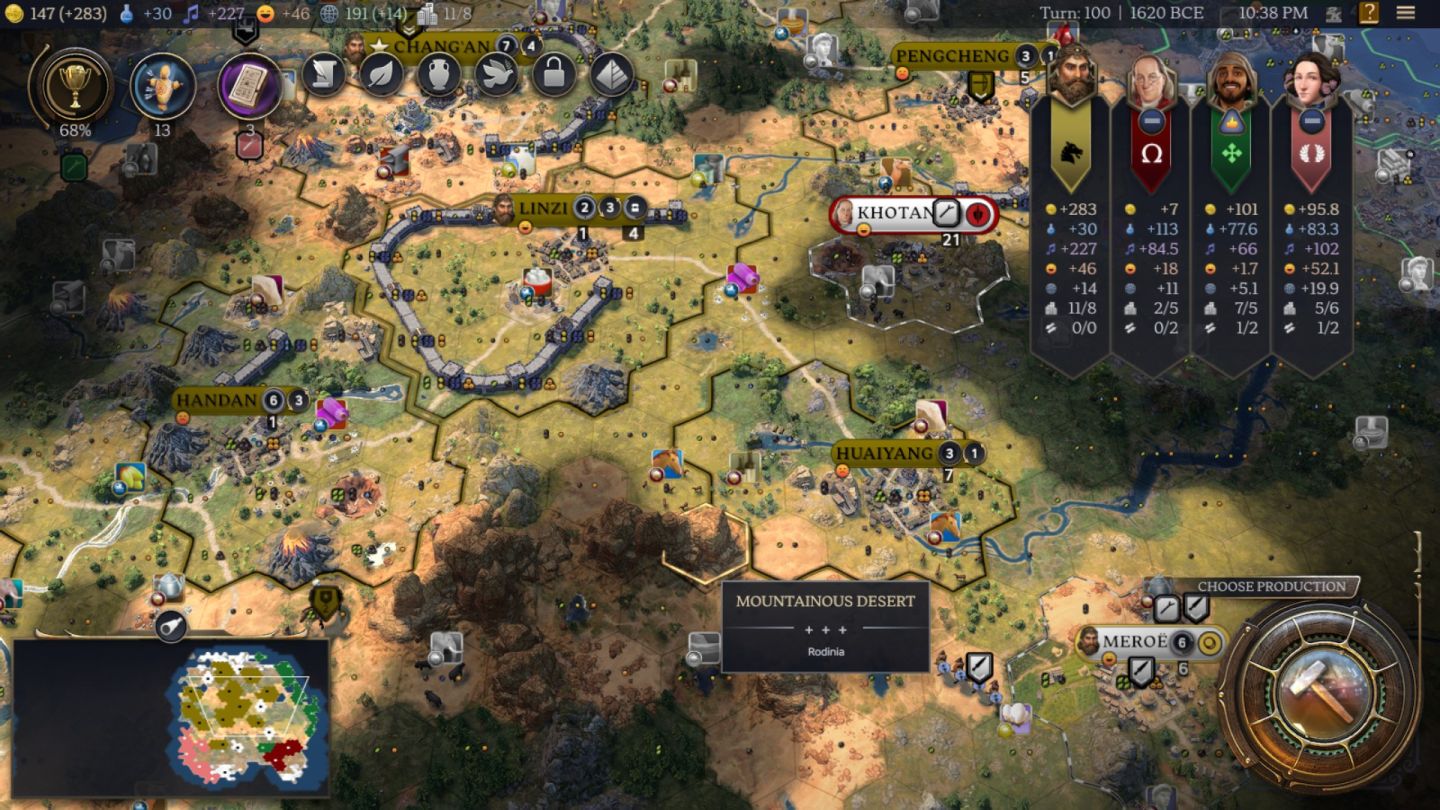
Thus by Turn 100 I was genuinely pulling away from the rest of the pack and starting to make the AI civs look downright sad. I had more income than all three of these turkeys put together, having crested 280 gold/turn and still climbing faster and faster. Poor Franklin had just signed a peace treaty giving away one of his cities and was down to a mere two settlements at 7 gold/turn income, yeeesh! Similarly, I had more than double the cultural output of any of these opponents and was closing in on exceeding all of them combined. Science was my one weakness but of course I would magically catch up with every missing tech at the start of the next era - great mechanic there, Civ7! The real problem here was the AI leaders simply not expanding well enough. I had 11 settlements by going well over the cap into slightly negative unhappiness whereas all three of them combined only had 14 settlements. And hold on, this deserves a bit more discussion. I had revealed the whole starting continent at this point so let's look closer at the minimap:
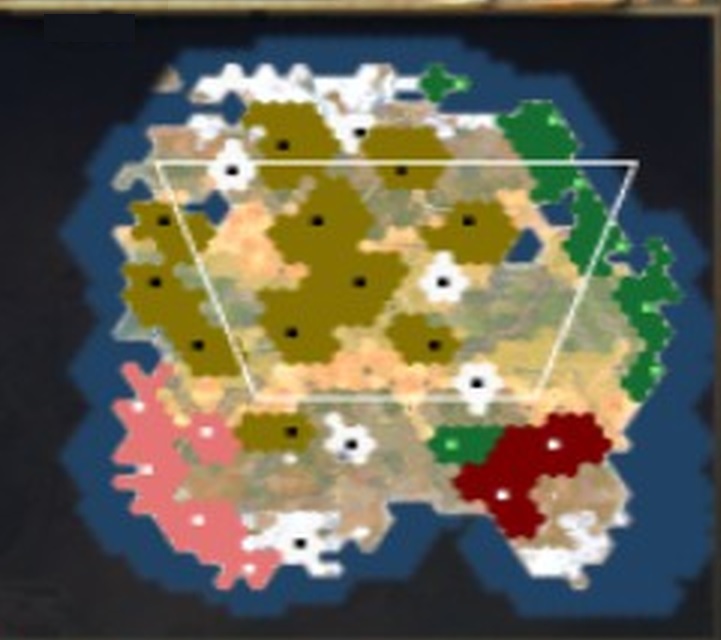
My Chinese civ has completely overrun this landmass from a starting position in the north-central portion of the map. The AI leaders simply refused to contest vast stretches of the continent, to which I've responded by happily gobbling them up for myself. There is absolutely no excuse for the player to get this much territory without firing a shot in anger, not on the hardest difficulty in the game! For no clear reason, the AI leaders in this game refused to expand quickly enough and the settlements that they did add were located in some really weird spots. Ibn Battuta was the poster child here as he appeared terrified to be more than ten miles from the coastline, throwing down a series of cities that gripped the eastern seaboard while leaving the entire interior of the continent to me. Ada Lovelace was nearly as bad, hugging the southwest coast and only moving inland with her fifth settlement that had been planted around Turn 95. As for Franklin, his performance had been so sad at this point that I couldn't even distinguish a pattern to his expansion, aside from noting that there was open and uncontested land in literally every direction around him. What's wrong with these guys?!
Since I couldn't realistically expand beyond my current eleven settlements, I had time to sneak in another wonder build at the capital in between Great Wall segments. I thought this would be worthwhile since it would also unlock the tier 1 scoring goal for the Cultural category and get me a couple of attribute points for the next era. My initial goal was to build Emile Bell for the unique endeavor which would add more food at Chang'an, only to see the wonder fall a single turn before it could have been completed at my capital. Good thing I was using Shift-Enter production abuse or I would have been left with nothing to show for my efforts! I was able to fall back on the Gate of All Nations (+2 war support on all wars) which was probably better anyway and which somehow hadn't been built by anyone despite being an early game wonder. This would be helpful for any future wars that might take place; I was still hoping to make it through the whole Ancient era without conflict.
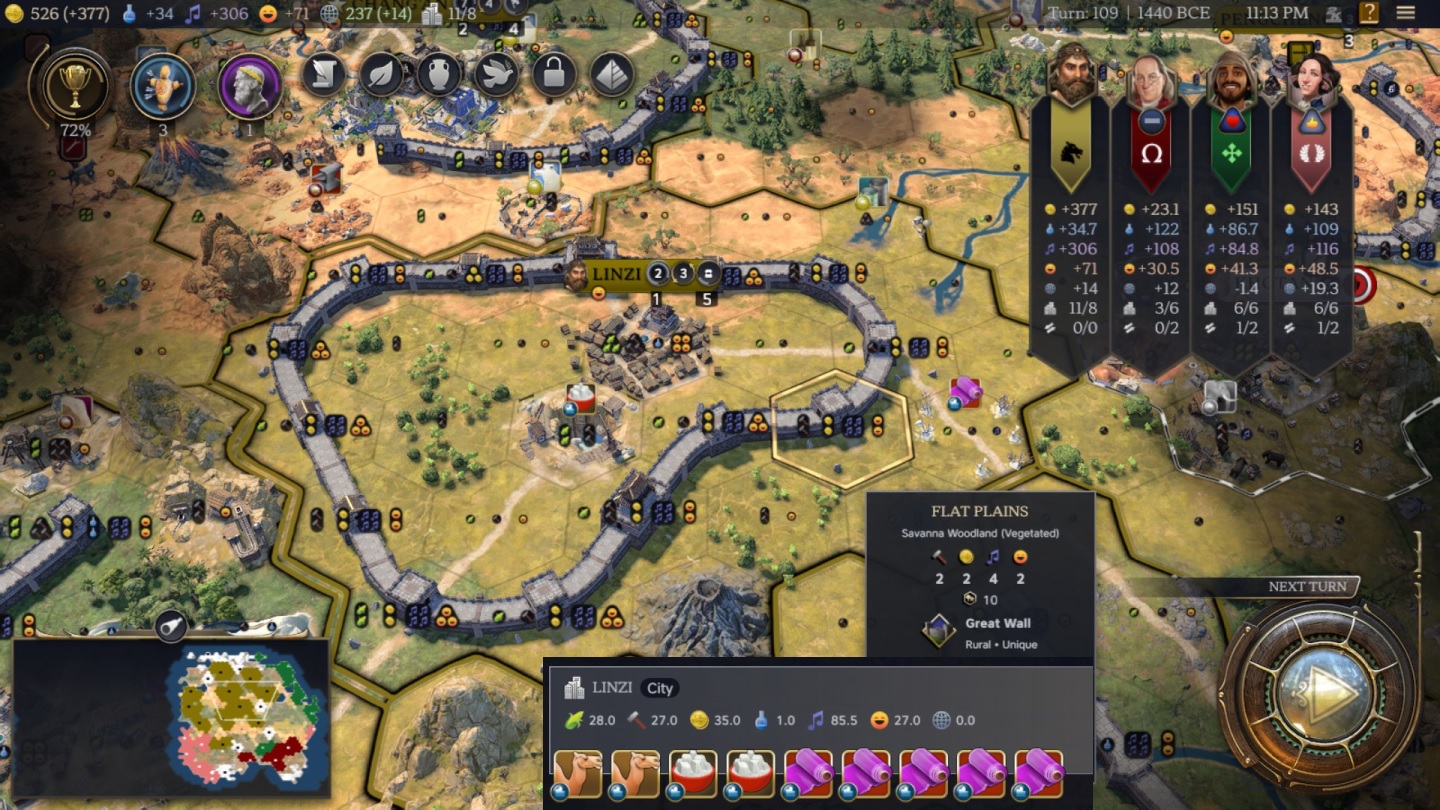
The age was starting to approach its endpoint now that I had passed Turn 100, and even if the percentage meter suggested that there was still something like 30% remaining on the clock, I knew that in practice the Ancient era would be finishing sometime around Turn 120-125. (This is another major problem with Civ7: the gameplay is way too formulaic with the ages always ending at roughly the same time in every game which gets boring very quickly.) More than a hundred turns of messing around with Great Wall bug abuse had led to some awesome results at my older settlements though, including this beautiful completed Great Wall at Linzi. I had initially planned to extend it a bit further to the northeast only to find that it wasn't possible due to the undocumented Great Wall rules; I'd have to be content with 14 segments. This added up to 85 culture/turn once I stacked five silk resources inside its resource slots, not too shabby for a city without a single urban building of any kind. The most amusing part of all: the repeated Great Wall segments had knocked Linzi all the way down to size 2! I actually couldn't build settlers here anymore because Linzi failed the size 5 requirement, heh.
Another boost to my growing settlements was the Farmer's Market endeavor offered by Ibn Battuta. This was an endeavor that only he could offer by virtue of having Expansionist trait (Achaemenid Xerxes has Cultural and Economic traits with their own associated endeavors) so I had to wait for him to offer it to me. When he did though, I happily supported it to get the full benefit of 3 food/turn in every town. Again, note that the benefit from this endeavor only applied to towns, not cities, yet another reason why it made more sense for me to keep almost all of my settlements as towns. More food meant more growths and more Great Walls continuing to blanket the map.
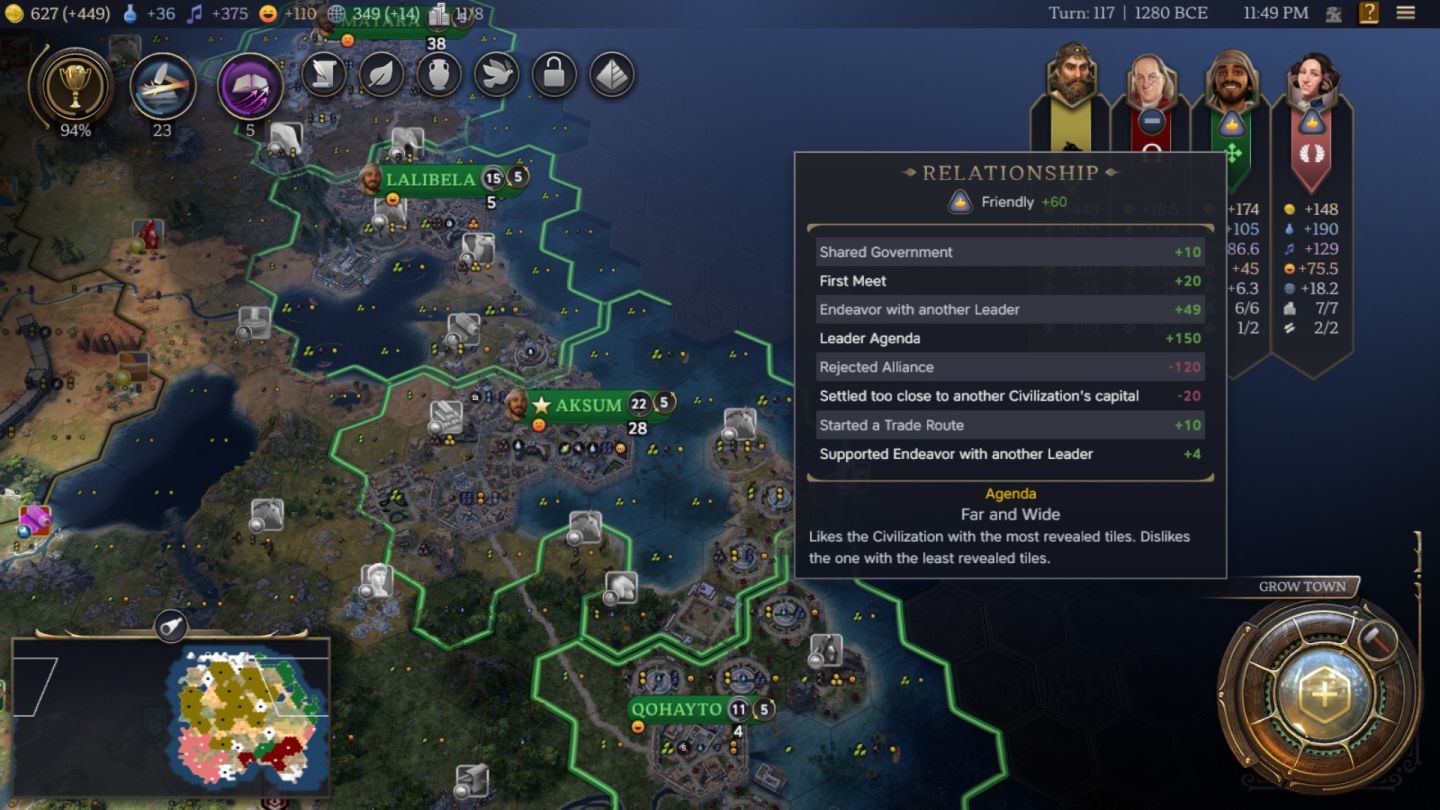
And here's the diplomatic summary of my interactions with Ibn Battuta near the end of the first era. I spent the whole Ancient era on great terms with this leader and he had no problem with Han China stealing away pretty much all of his land while he fought silly wars with the other leaders. Note that it turns out to be reasonably easy to make friends with the AI leaders in this game, at least if the player is using fair maps and not the rigged ones that the developers have set as the default option. Shared endeavors along with trade routes are sufficient for 40-60 positive diplomatic points and those plus the friendly initial greeting will take the meter to somewhere around 80 points. The biggest sticking points are the "settled too close to the capital" penalty, which is almost unavoidable on the Standard map setting, and then the leader agenda which can be nearly impossible to fulfill for someone like AI Xerxes or AI Catherine. I had the opposite issue with Ibn Battuta: I was achieving his "explore the map" agenda too well! He was giving me 150 positive diplomatic points in that category, which was then canceled out by asking me for an alliance four separate times which I had to keep rejecting. I wish that the AI wouldn't do this but it seems to be a deliberate attempt to poison relations: if they do like you a lot, they'll spam alliance requests and then get upset on refusal. I had no choice though as I had zero desire to get dragged into Battuta's stupid conflicts with Ada and Franklin. The whole alliance thing does feel a bit like a treadmill system as any time that the player manages to build positive relations, the gameplay immediately throws them out again or else forces you to share in the idiotic AI fighting. This is close to being a good system without quite achieving it yet.
In any case, the era meter in the corner of the screen proved to be full of lies again in this game. It was sitting at 72% on Turn 109 but had climed to 94% a mere eight turns later on Turn 117 as various civs kept on completing the scoring goals for the Ancient era. My own Chinese were very much guilty in that regard as I finished the whole civics tree and advanced the meter by completing a "Future Civic", then also accidentally slotted in a 20th resource for the tier 3 Economic scoring goal. (I picked a tin resource at Linzi when it grew and the game automatically slotted it into the city to complete the scoring goal, never asking me if I wanted it to go there - thanks.) My eleven settlements had me sitting at 11/12 in the final scoring goal for the Military category and I had a cheeky plan to complete that objective as well. With the era meter sitting at 95% on Turn 120, I dropped two new settlements simultaneously:
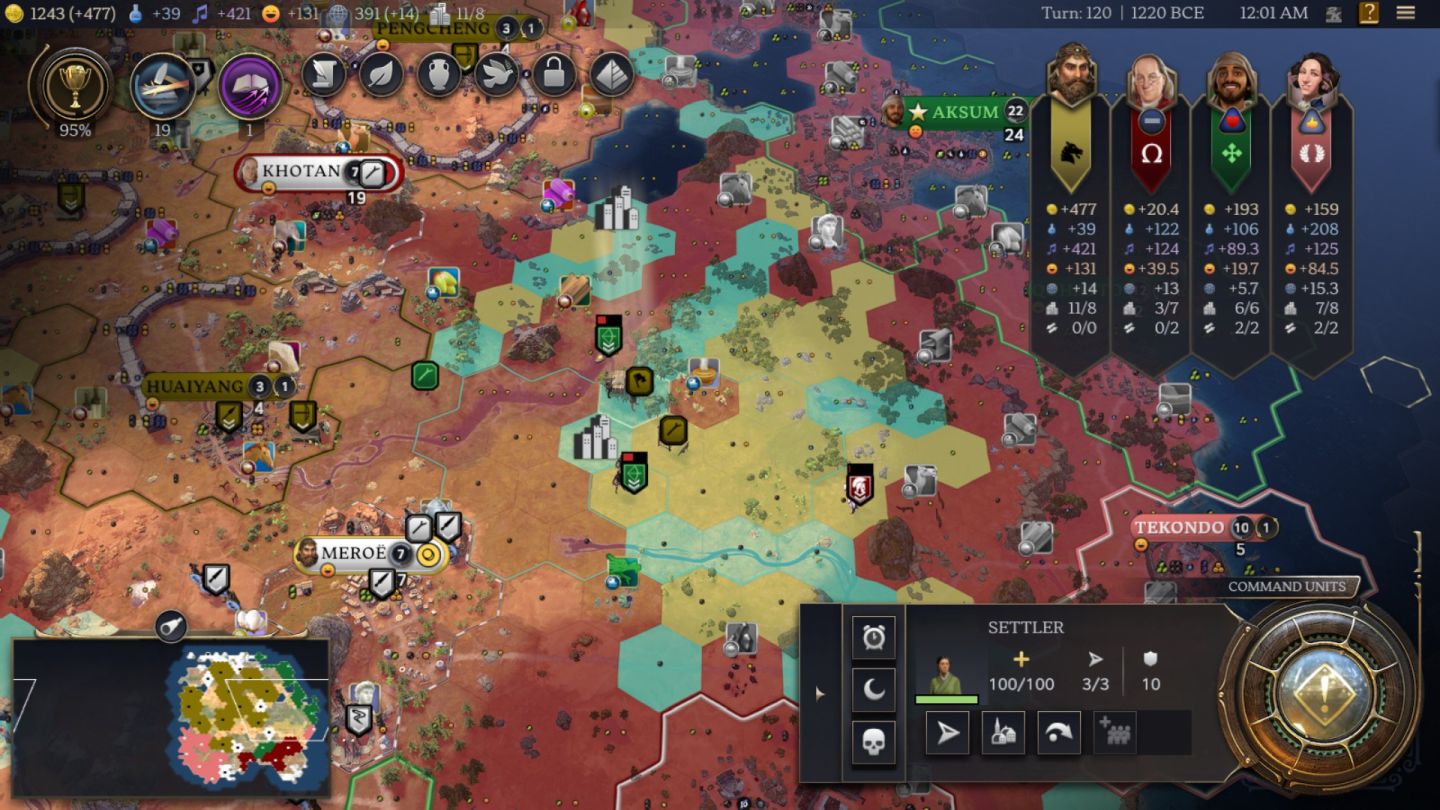
One of them went over here along the border with Ibn Battuta who somehow didn't have control of this territory a stone's throw away from his capital. (He had recently signed away one of his cities in a peace treaty which was how Ada Lovelace had a town way over on the east coast.) I put the other settlement in the extreme northwest corner of the map where there was barely enough room for a town in the tundra. Together they brought me up to 13/8 settlements which was too far over the limit even for a civ with my Great Walls to boost happiness. However, it didn't matter that I was far over the settlement cap because the era was literally ending on the same turn! Adding the twelfth settlemet had finished the Military scoring goal and increased the era meter to 100% as I had been expecting. And by the time that the Exploration age began, that settlement cap would be greatly increased since I'd be getting the default +1 per age, another +2 from the Fealty legacy, and a final +1 from picking Corona Civica again. This was the most settlements that I'd ever had in the Ancient era and amazingly I obtained all of them completely peacefully. Farmer's Gambit for the win!
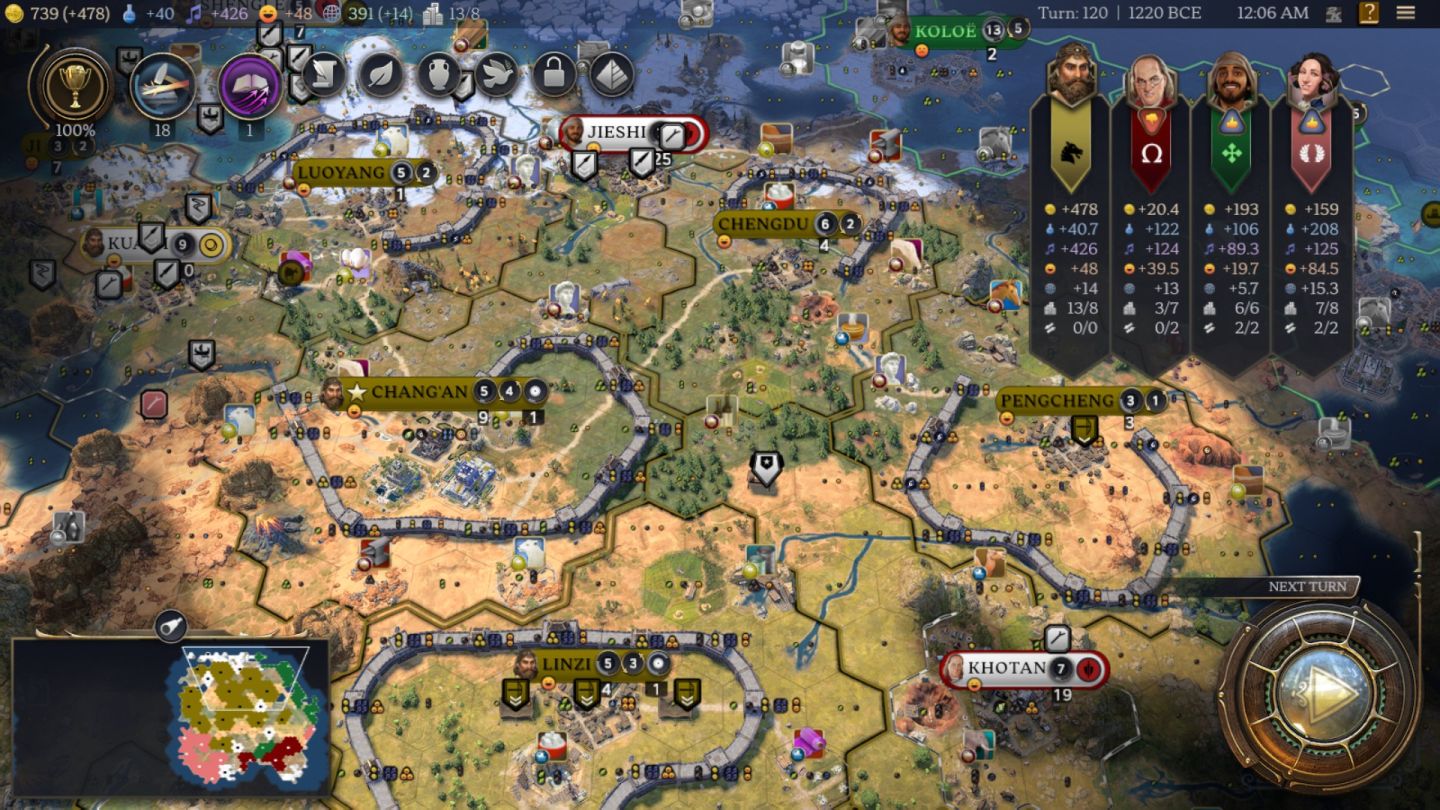
Therefore this was the final overview screenshot at the end of Turn 120 with my baker's dozen of settlements established. I had Chang'an and Linzi squeezing out some Foederati units on the final turns, units that unlock as one of the options from a Military city state alliance. Those things are cheap and not very good in terms of combat but hopefully they would transform into real units across the era transition. Elsewhere, my civ's yields were depressed slightly from being so far over the settlement cap and having -25 unhappiness in every settlement as a result. Even with that caveat though, the Han Chinese had utterly annihilated their AI competitors. I was making nearly 500 gold/turn which was sufficient to cash-rush three Great Wall segments each turn, with cultural output to match that now exceeded every other leader combined. The whole continent looked like a blob of Xerxes brown with small enclaves of competing colors dotting the coastlines. I couldn't have asked for a better initial era and somehow I even outscored all of the other AI leaders in the legacy scoring goals despite being unable to compete in the Science category. Ibn Battuta had only five resources allocated to his settlements - FIVE! And Franklin had even less than that!!! 

China's dominance on this map was written into the very landscape itself with all of the unique tile improvements everywhere. I had an obscene number of Great Wall segments dotting the landscape and still with plenty of room for more walls yet to come. On that note, I was nowhere near finished yet with this wacky concept. Oh yes, the Ming Chinese get their own version of the Great Wall, and it's equally bugged too! We're doing this again in the next era! Stay tuned for more ridiculousness ahead.



